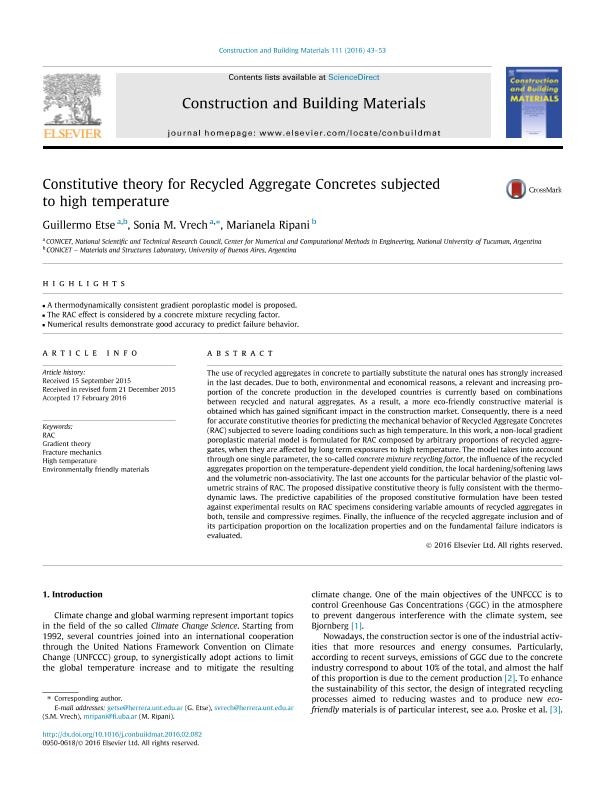Mostrar el registro sencillo del ítem
dc.contributor.author
Etse, Jose Guillermo

dc.contributor.author
Vrech, Sonia Mariel

dc.contributor.author
Ripani, Marianela

dc.date.available
2018-05-09T14:02:00Z
dc.date.issued
2016-05
dc.identifier.citation
Etse, Jose Guillermo; Vrech, Sonia Mariel; Ripani, Marianela; Constitutive theory for Recycled Aggregate Concretes subjected to high temperature; Elsevier; Construction And Building Materials; 111; 5-2016; 43-53
dc.identifier.issn
0950-0618
dc.identifier.uri
http://hdl.handle.net/11336/44565
dc.description.abstract
The use of recycled aggregates in concrete to partially substitute the natural ones has strongly increased in the last decades. Due to both, environmental and economical reasons, a relevant and increasing proportion of the concrete production in the developed countries is currently based on combinations between recycled and natural aggregates. As a result, a more eco-friendly constructive material is obtained which has gained significant impact in the construction market. Consequently, there is a need for accurate constitutive theories for predicting the mechanical behavior of recycled aggregate concretes (RAC) subjected to severe loading conditions such as high temperature. In this work, a non-local gradient poroplastic material model is formulated for RAC composed by arbitrary proportions of recycled aggregates, when they are affected by long term exposures to high temperature. The model takes into account through a single parameter the dependence of the temperature-dependent yield condition degradation, and of the gradient and fracture energy based softening laws on the proportion of recycled aggregates. The proposed dissipative constitutive theory is fully consistent with the thermodynamic laws. The predictive capabilities of the proposed constitutive formulation have been tested against experimental results on RAC specimens considering variable amounts of recycled aggregates in both, tensile and compressive regimes. Finally, the influence of the recycled aggregate inclusion and of its participation proportion on the localization properties and on the fundamental failure indicators is evaluated.
dc.format
application/pdf
dc.language.iso
eng
dc.publisher
Elsevier

dc.rights
info:eu-repo/semantics/openAccess
dc.rights.uri
https://creativecommons.org/licenses/by-nc-sa/2.5/ar/
dc.subject
Rac
dc.subject
Gradient Theory
dc.subject
Fracture Mechanics
dc.subject
High Temperature
dc.subject
Environmentally Friendly Materials
dc.subject.classification
Ingeniería de los Materiales

dc.subject.classification
Ingeniería de los Materiales

dc.subject.classification
INGENIERÍAS Y TECNOLOGÍAS

dc.title
Constitutive theory for Recycled Aggregate Concretes subjected to high temperature
dc.type
info:eu-repo/semantics/article
dc.type
info:ar-repo/semantics/artículo
dc.type
info:eu-repo/semantics/publishedVersion
dc.date.updated
2018-05-04T16:47:08Z
dc.journal.volume
111
dc.journal.pagination
43-53
dc.journal.pais
Países Bajos

dc.journal.ciudad
Amsterdam
dc.description.fil
Fil: Etse, Jose Guillermo. Consejo Nacional de Investigaciones Científicas y Técnicas; Argentina. Universidad Nacional de Tucuman. Facultad de Ciencias Exactas y Tecnología. Centro de Metodos Numericos y Computacionales En Ingeniería; Argentina. Universidad de Buenos Aires. Facultad de Ingeniería. Departamento de Construcciones y Estructuras. Laboratorio de Materiales y Estructuras; Argentina
dc.description.fil
Fil: Vrech, Sonia Mariel. Consejo Nacional de Investigaciones Científicas y Técnicas; Argentina. Universidad Nacional de Tucuman. Facultad de Ciencias Exactas y Tecnología. Centro de Metodos Numericos y Computacionales En Ingeniería; Argentina
dc.description.fil
Fil: Ripani, Marianela. Consejo Nacional de Investigaciones Científicas y Técnicas; Argentina. Universidad de Buenos Aires. Facultad de Ingeniería. Departamento de Construcciones y Estructuras. Laboratorio de Materiales y Estructuras; Argentina
dc.journal.title
Construction And Building Materials

dc.relation.alternativeid
info:eu-repo/semantics/altIdentifier/doi/https://dx.doi.org/10.1016/j.conbuildmat.2016.02.082
dc.relation.alternativeid
info:eu-repo/semantics/altIdentifier/url/https://www.sciencedirect.com/science/article/pii/S0950061816301416
Archivos asociados
